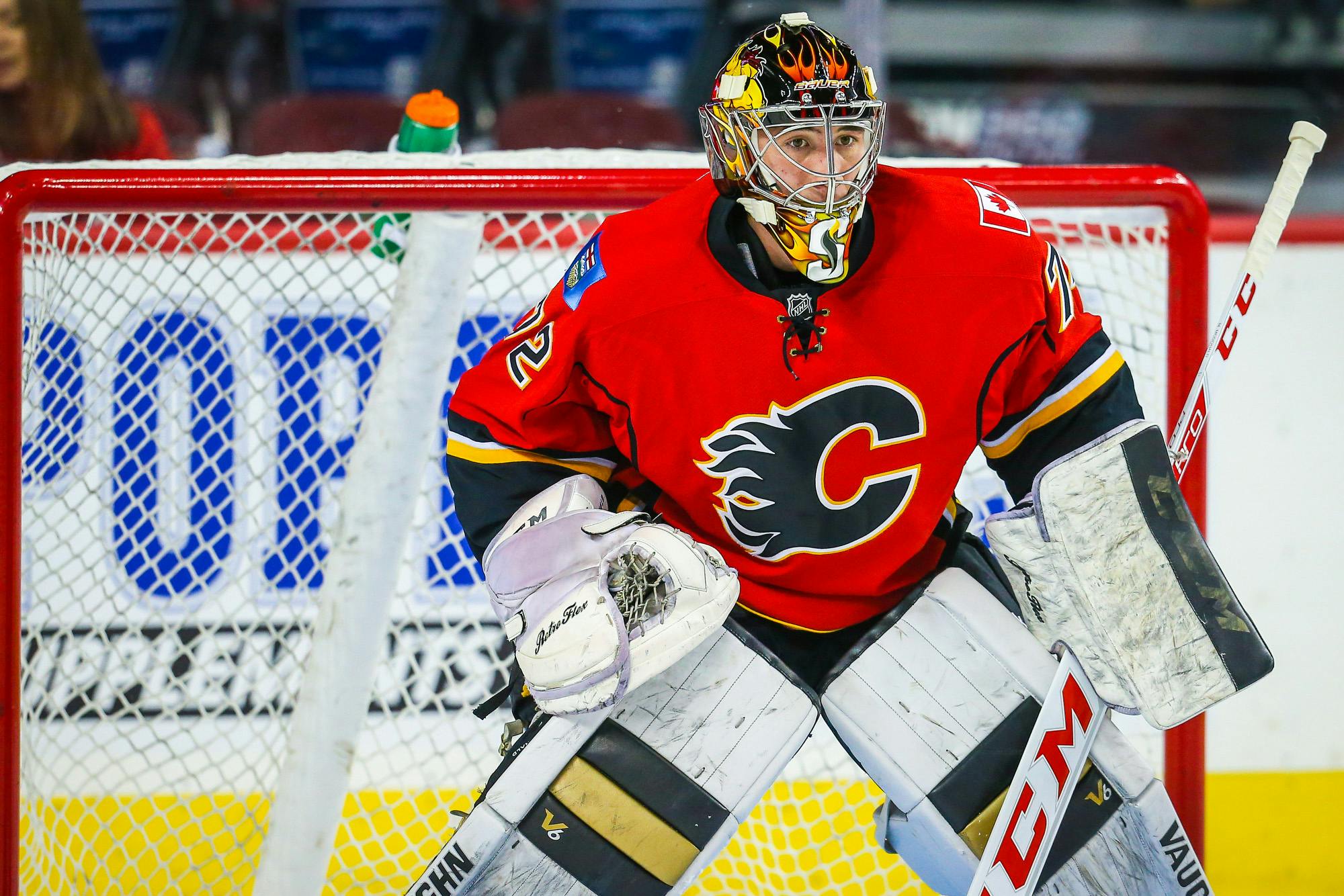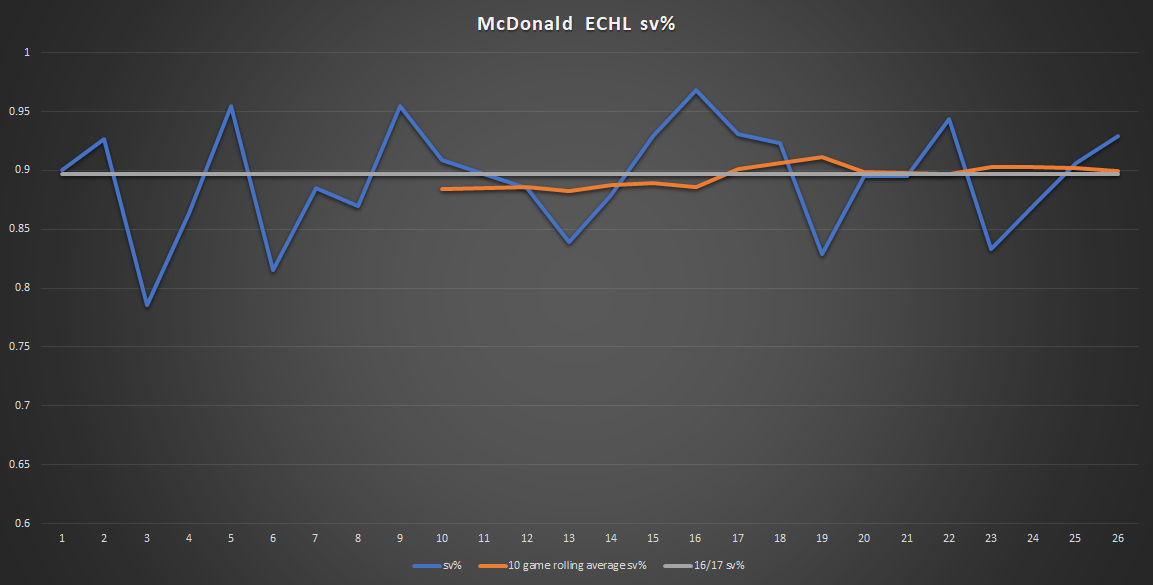Nation Sites
The Nation Network
FlamesNation has no direct affiliation to the Calgary Flames, Calgary Sports and Entertainment, NHL, or NHLPA
FlamesNation prospect wrap-up: Mason McDonald

Photo credit: Sergei Belski-USA TODAY Sports
May 5, 2018, 10:00 EDTUpdated: May 5, 2018, 03:05 EDT
There’s always a fear around drafting goaltenders high. Although goaltending is not voodoo, NHL success at the goalie position is more difficult to project than forwards and defencemen.
Flames 2014 second round pick Mason McDonald is a case of balancing hype versus actual performance. The netminder was one of the most hyped heading into the draft, but has seemingly fallen on his face in the pros. His first season could arguably be written off due to him being a rookie, but his sophomore year has reinforced doubts, especially given the rise of Tyler Parsons.
Background
As a junior, McDonald had plenty of hype behind his name. He had some mixed success at the QMJHL level, but a very strong performance at the U18 WJC and a post trade revival in Charlottestown moved him up the draft boards. He was ranked #2 for North American goalies and various scouting services placed him as a second rounder. Appropriately, the Flames picked him up in that round for the 2014 draft.
Things looked better in his draft+1 year. McDonald played 56 games for the Islanders, finishing third in SV% among QMJHL goalies who played more than 20 games. His strong performances earned him an invite to Hockey Canada’s summer camp and potentially a WJC spot.
Somewhere in his D+2 year, the wheels came off for McDonald. Although still nominally the starter for Charlottestown, he lost 17 starts (to a 5’8, 16-year-old rookie) as he battled some minor injuries and some shaky play. He did make Canada’s WJC team, but only started two games where he looked okay at best.
His first year of pro hockey was also rough. The Halifax product played the most out of any Adirondack Thunder goalie, but frequently lost the net to journeymen like J.P. Anderson and Ken Appleby. He finished the season with a .897 SV% and didn’t really make any impressions.
2017-18 story
The Flames swapping ECHL affiliates opened up an opportunity for McDonald: the team would no longer have to split affiliations with the New Jersey Devils, allowing them to have more control over the roster. This would mean that McDonald would no longer have to sit for a Devils prospect, like what happened with Appleby the year before. There was the opportunity for more playing time and potentially the starter’s spot.
The downside for McDonald was that he faced tough competition for that spot against Parsons. In the early goings of the season, McDonald lost out thanks to Parsons playing lights out hockey. Although injury opened up that starter’s spot, McDonald wasn’t really that impressive. He also had a brief stint with the Heat while the Flames’ goalie situation was a mess, but didn’t really make an impression. In Stockton, he suffered an injury and only came back for the final few games of Kansas City’s season.
The numbers
GP | MIN | SV% | SA | GA | SV% rank (/41) | SA rank | GA rank | |
ECHL | 27 | 1538 | .894 | 762 | 81 | 40 | 40 | 11 |
AHL | 4 | 224.35 | .875 | 104 | 13 | did not qualify | dnq | dnq |

McDonald struggled through the early part of the season, but seemed to have found a rhythm later on. Then he got injured and we didn’t hear from him for a while.
And that’s probably the only promising thing about McDonald’s season: he got hot for a few games. Throughout the year, he was one of the worst ECHL goalies among those that played 1,440 minutes (about 24 games, ECHL’s definition of qualified). He ranks next to last in save percentage despite an also next to last workload. He didn’t see that much action, but he didn’t really deserve that much more action.
McDonald’s main problem is that he’s just consistently a below average goalie. Nine of his starts fall above the .915 SV% line, which generally signifies a great performance, but five of his starts fall below the .850 SV% line, which is the opposite of a great performance. The remaining 12 fall between the two. For comparison, Parsons had 14 starts above .915 SV% and seven in each of the other two categories. Parsons may not have been consistent in his appearances, but still kept his team in the game for the most part. The same can’t be said for McDonald.
I wouldn’t read into his AHL time too much, as he pretty much got thrown in cold and then got injured (not to mention a four-game sample size), but he still wasn’t that great there.
The future
McDonald will probably stay put in Kansas City for next season, getting the majority of starts while Nick Schneider backs him up. Sorry, Mavs fans.
It’s his last year of his ELC, which is pretty bad news when you consider the Flames’ goalie depth (if their drafting history remains true, they’re probably drafting another goalie this year). McDonald hasn’t really proven any of his doubters wrong during his pro tenure: he’s been a below average goalie in a weak league. He already has lost his job to a 19-year-old rookie in Parsons, who has pretty much turned McDonald into an organizational afterthought.
Unless McDonald takes a major step forward, he’s likely done with the org after next season. It’s hard to quantify exactly how major this step needs to be, but he basically needs to play his way into the Rittich/Gillies/Parsons conversation. Given his career history, he would have to go back to his 18-year-old self. That’s going to be a lot of work and also extremely unlikely.
Previously
Recent articles from christian tiberi
Breaking News
- Flames Prospect Roundup: How the standings shape up entering the holiday break
- NHL Notebook: Sidney Crosby takes sole possession of most points in Penguins’ franchise history
- FlamesNation Mailbag: Waiting for Santa with reader questions
- Flames injury news: positive signs for Martin Pospisil
- Recap: Martin Frk leads Wranglers to memorable Winter Wranglerfest win in more ways than one
